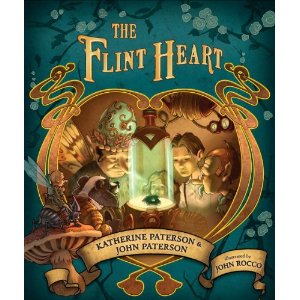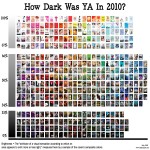10 Aug
The Rule of 3: The Flint Heart by Katherine and John Paterson
Posted in Book Reviews, Craft, Kid Lit, Writing
“A man, a woman and an emu walk into a bar…” We’ve all heard that joke before, or at least something along those lines. They’re always told the same way, with two parts building up to a third that is the punchline. The Rule of 3.
We hear this pattern in songs too. “Here an oink, there an oink, everywhere an oink oink.” But I’m not just talking about children’s songs either; jazz and blues are filled with the Rule of 3.
The best way to illustrate the Rule of 3 in the blues would be to quote the lyrics of the hilarious parody Poppa’s Blues from the musical Starlight Express:
The first line of the blues is always sung a second time.
The first line of the blues is always sung a second time.
So by the time you get to the third line, you’ve had time to think of a rhyme.
The Rule of 3.
Finally, we also see this pattern in stories. The perfect example, of course, is “I’ll huff, and I’ll puff and I’ll blow your house in!” Not to mention that there were three little pigs, one with a house of straw, one with a house of sticks and one with a house of bricks. The Rule of 3.
This rule is alive and well in Katherine and John Paterson’s gorgeous book, The Flint Heart, where the evil Flint Heart causes trouble for the woodland community not once, not twice, but a full three times. This beautifully illustrated novel proves that even today, this age-old technique of grouping things in threes is still quite effective.
So, how does the Rule of 3 work, exactly? Doesn’t the reader see the punchline coming? Why is it that even though it’s been around for what seems like forever, the Rule of 3 still holds that element of surprise and satisfaction? Here’s why:
1) There’s always three. Not two. Not four. Three. Why three? Because it’s enough to set up a pattern in the reader’s mind, but not so much that the reader gets bored. If you repeat something only once, it’s not enough for the reader to notice the effect, but if you do it three times, then you’ve got the reader’s attention.
2) There’s a build-up. Part of the reason why the Rule of 3 is so effective is that when writers use it, they build each piece on the previous one. The Flint Heart is a perfect example. The first time the flint heart causes trouble, it is only within the context of one human family. Next it causes problems within the fairy kingdom. Finally, the flint heart creates trouble for the entire woodland community, affecting humans, fairies and all the creatures of the forest. Each iteration is more intense and has higher stakes than the last.
3) Third time’s the variation. Finally, the Rule of 3 works because the third time is never exactly the same as the first or second. Think of the three little pigs. The first two houses get blown to smithereens but the third house of bricks is what does in the Big Bad Wolf. Think of jokes, where the punchline comes at the end of a chain of three. Think of the Blues, where the first two lines are often the same, with a variation coming in the third and final line. Using the first two iterations to establish a pattern, you can then add a variation or twist with the third. That catches the readers attention and leads to that element of surprise and satisfaction.
Have you used the Rule of 3 in your writing? How?







 Call me Gabi (pronounced gah-BEE). I'm a writer, freelance teacher, and a lover of books and words. I'm also the instigator of DIY MFA. iggi's my sidekick, but he thinks he's the brains behind this operation.
Call me Gabi (pronounced gah-BEE). I'm a writer, freelance teacher, and a lover of books and words. I'm also the instigator of DIY MFA. iggi's my sidekick, but he thinks he's the brains behind this operation.
 Goodbye is for Sissies
Goodbye is for Sissies YA Cafe: What YA Book are You Thankful For?
YA Cafe: What YA Book are You Thankful For? YA Cafe: Why I Love Dark YA
YA Cafe: Why I Love Dark YA YA Cafe: YA Appreciation Month
YA Cafe: YA Appreciation Month
Comments on this post
There’s a wonderful spoken word piece on Spoken Revolution where the poet is talking about “How to Write a Political Poem.” Here, I found it online:
http://foxthepoet.blogspot.com/2010/04/how-to-write-political-poem-by-taylor.html
Anyway, I definitely do it. The other day I was working my way through one of your DIYMFA exercises and I noticed I had dropped myself into pairs rather than trios. Hmmm . . . not sure if this is indicative of the character’s rhythm of thinking or what. It’s curious though. I see it and sometimes I strive for it, other times I go, “Okay, say something one way so pick one and drop the other two.”
10. August - 12:43 pmGood post. I learned about this in a children’s writing class and I’ve used it in my writing. Good examples of the rule of three.
10. August - 12:43 pmThis is a really good tip and one I definitely use in my writing. I like the Blues example you gave because it shows how the third piece can have that twist.
10. August - 3:47 pmOMG–Satia, that poem you linked to is hilarious! And definitely uses the rule of three at the end!
12. August - 6:21 pm